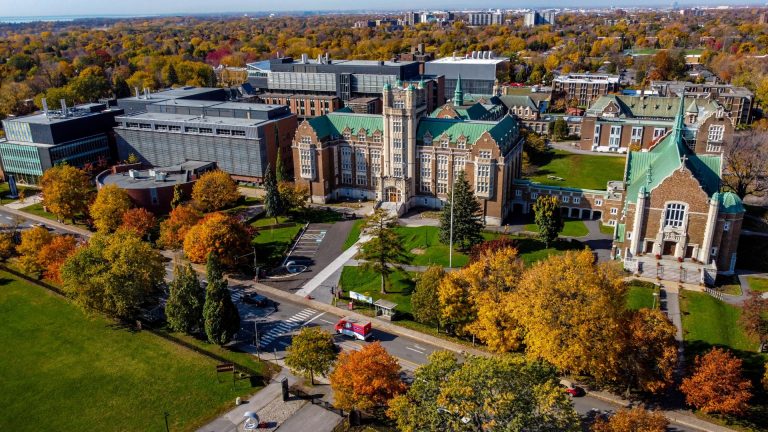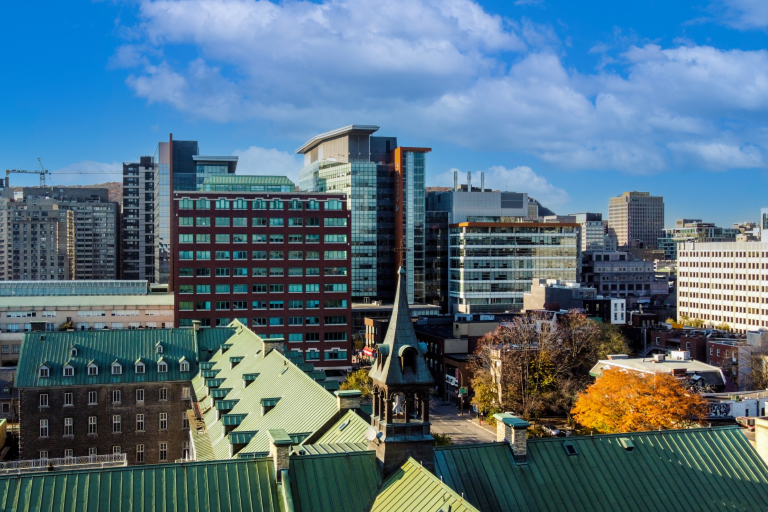Concordia Campus Master Plan consultations ramp up

Concordia’s population of students, faculty and staff has been growing steadily over the years.
Though it may be hard to imagine while most university community members are still working and studying from home, projections point to a space deficit equivalent to three John Molson buildings over the next 10 to 15 years – assuming space norms remain consistent and trends persist.
Concordia will also have to develop additional physical and digital infrastructure to address emerging needs and priorities and allow it to meet its academic mission.
One way to address this is with the smart use of space, which explains the big push to redesign buildings like Henry F. Hall and parts of the Faubourg.
However, that work has required extraordinary measures like creating the temporary Learning Square and signing long-term rental agreements with other building owners.
It also means that when engaging with the City of Montreal, projects are considered individually rather than as part of a comprehensive vision. To redress the situation, Facilities Management is developing a new Concordia Campus Master Plan.
“The master plan is an important tool in establishing a shared vision for the Loyola and Sir George Williams campuses,” explains Marie-Claude Lavoie, associate vice-president, Facilities Management.
“It involves coordinating with the city and inviting into the process the larger community. The result is a document that serves both as an expression of vision and goals and as a regulatory instrument.”
The previous master plan, dating back to 2001 and updated a couple of times, served the university well. However, it has become outdated because of development – on and off campus – and because of evolving community needs.
“Our focus is on the macro level: the buildings, green spaces and ways we get around,” adds Dominique Dumont, director of strategic planning and development.
“At the same time, that forces us to reflect on a range of subjects like sustainability, accessibility, mobility, inclusion and how our spaces interface with public, residential and commercial ones.”

Community feedback is key
Though Facilities Management is responsible for drawing up the plan, its success will be dependent on gathering both expert and community feedback. Assisting in that process is the multidisciplinary firm Provencher_Roy. Along with Concordia planners, it has undertaken a thorough review of all buildings and grounds to better understand how spaces currently serve those who use them.
"An exercise of this magnitude will have a significant impact on the Concordia community as well as on the surrounding neighbourhoods," says Julie Bergeron, urban planner at Provencher_Roy.
"It is essential that communities embrace the vision and that it be shared and collectively endorsed. We need to engage throughout the process in creative, progressive and productive ways to allow for involvement to take place, particularly in a time of pandemic."
The Campus Master Plan exercise will focus consultations along nine broad themes:
- Campus density
- Sustainability
- Mobility and transport
- Campus–city interface
- Heritage
- Inclusion and accessibility
- Health and wellness
- Social acceptability and community
- Public domain
Some themes are being addressed in meetings and ideation sessions. Others allow for less time-constrained feedback. To simplify that process, Facilities Management is piloting a new engagement platform, open to everyone. It allows Concordians and external parties to submit ideas and comments from wherever they currently are in the world.
“The platform we’re testing is used by many municipalities in Europe and North America for processes like our master plan exercise. It comes with privacy safeguards as well as flexible tools,” Dumont explains.
A first round of broad consultations is taking place from mid-May to the end of June 2021. During that time, people can post suggestions and comment on those of others. There are currently two main ways to do that: the ideas wall or through pins on a map.
Both can also include photos to help illustrate points. Participants can endorse or disagree with ideas with the click of a button or by adding comments. In the following months, more activities will be launched, seeking more feedback from the community.
To engage on the platform, users need to create an account as a means of accountability. Having some basic information about contributors will also allow the project team to get a sense of reach, to understand if they need to do more to inform people of the project and have the opportunity to provide feedback.
Those who do not wish to complete the mandatory name and email fields can still read the suggestions of others and find information about the process; they just won’t be able to comment or propose ideas.
“We are very excited to be collaborating with diverse groups in this process – one that will be instrumental for the future of Concordia and its place within our city,” says Lavoie. “We want as many voices as possible helping us form our long-term vision for the campuses.”
To learn more about the new Concordia Campus Master Plan visit the engagement platform or read more on the concordia.ca web page.


